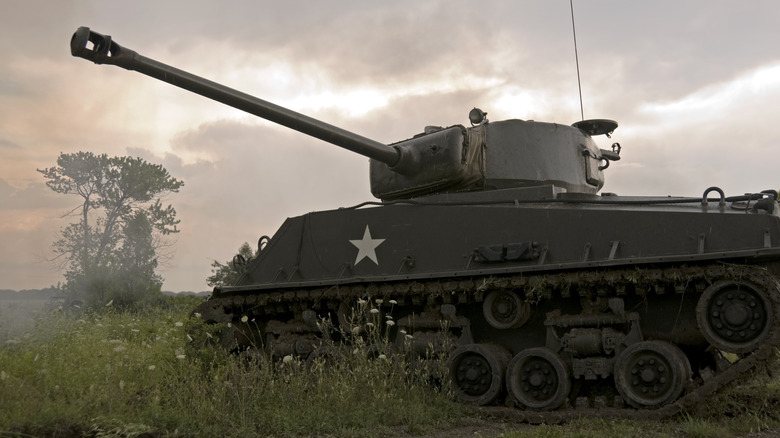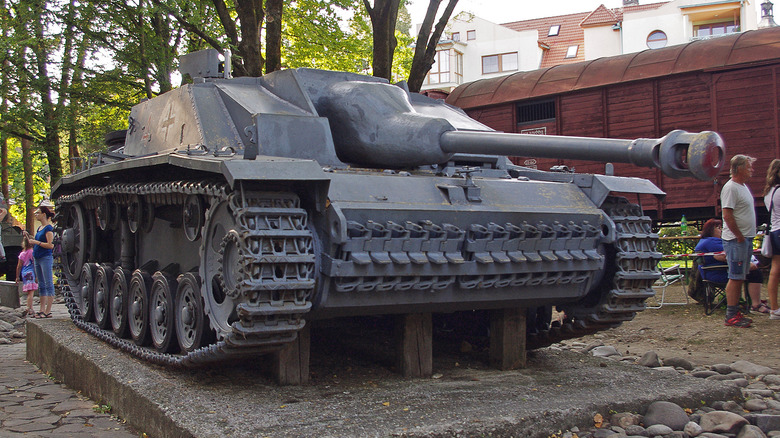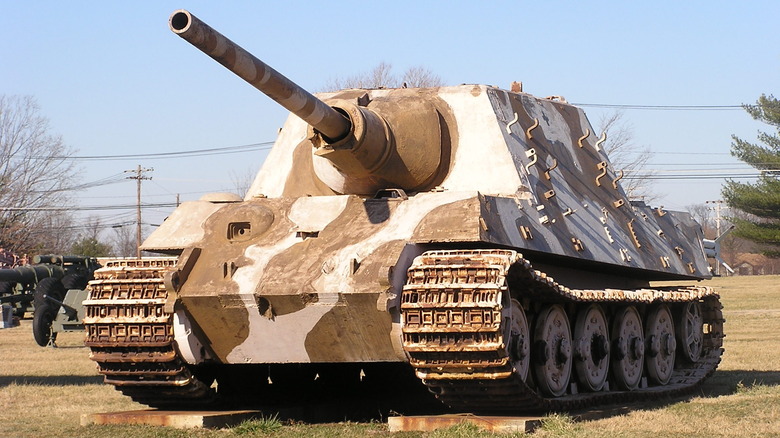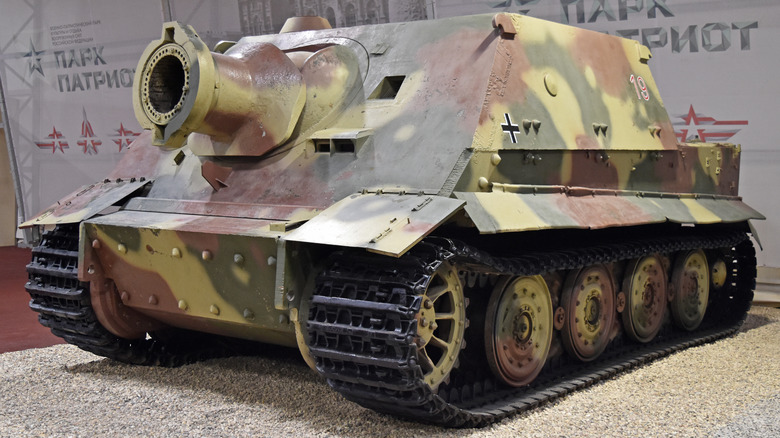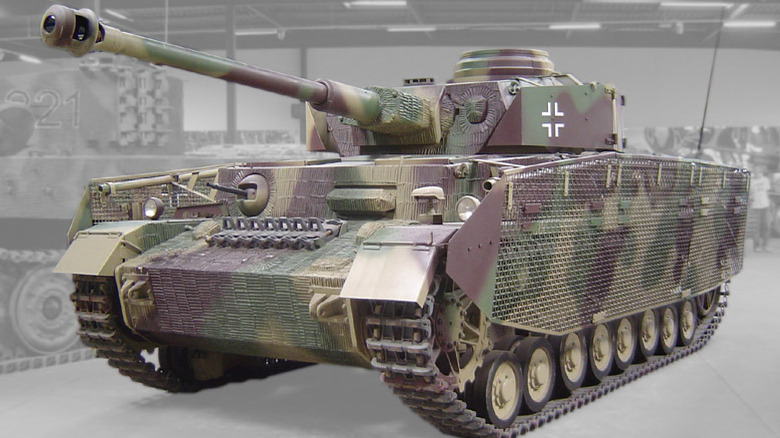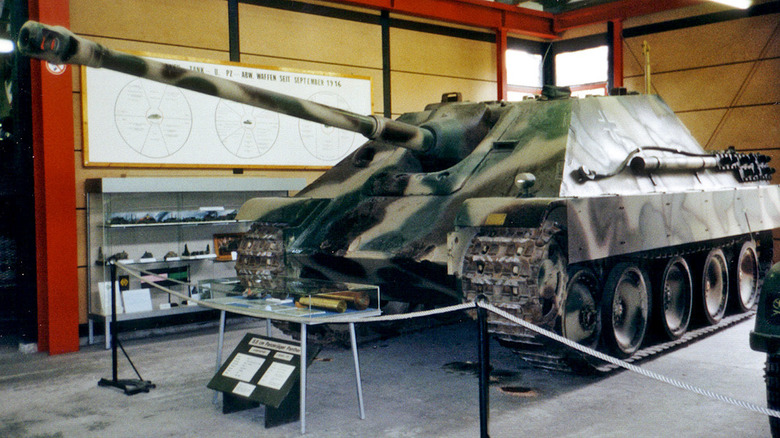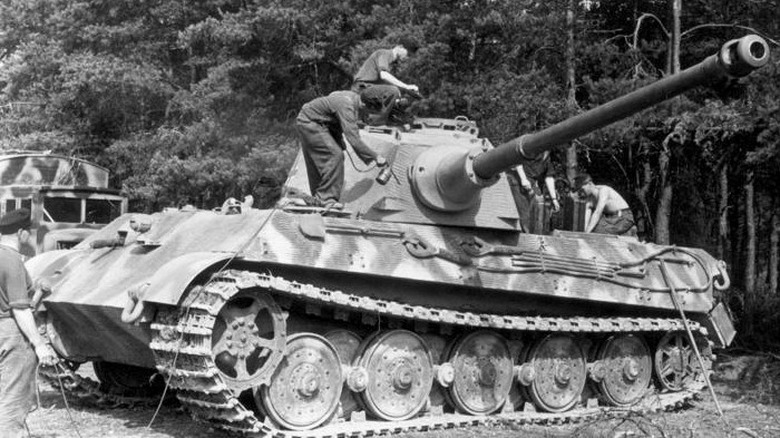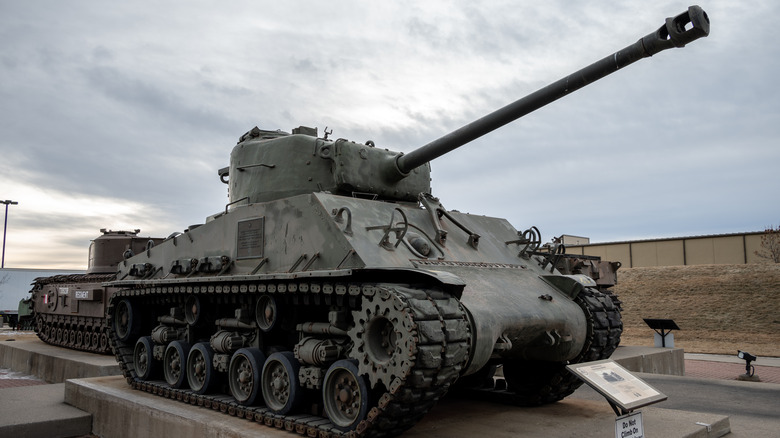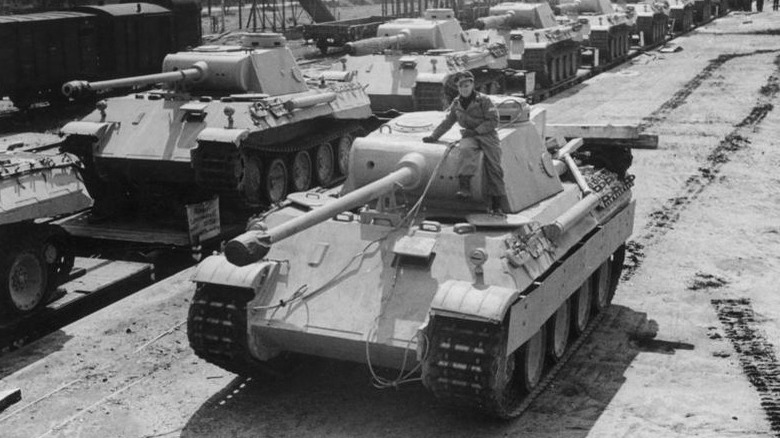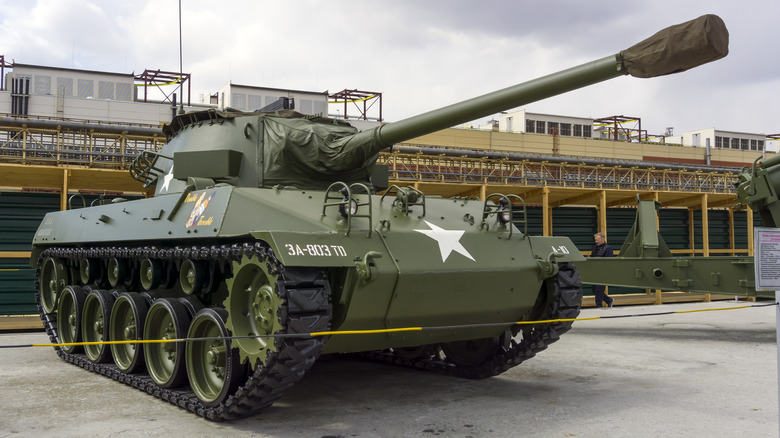A Look At The Tanks Involved In The Battle Of The Bulge
The Allied invasion of Europe in June of 1944 saw troops embark on a campaign aimed at the very heart of Germany. The dense hedgerows of Normandy took longer to fight through than expected. Still, by late summer of 1944, Allied trips had captured Paris and were racing toward the French-German border. When Operation Market Garden, an abortive autumn invasion of the Netherlands, failed to kick open Nazi Germany's back door, it became clear the war would not be over by Christmas.
By the middle of December 1944, Allied Supreme Commander Dwight Eisenhower controlled a 600-mile front that stretched from the North Sea to Switzerland. But Hitler had a plan — a devastating counter-punch that would clear the way to Antwerp, cutting the British off from their allies and the Americans from their supplies. The brass knuckles on Germany's fist: their vaunted Panzer divisions.
The biggest tank skirmish in history, the Battle of Kursk, had occurred the year before, and it was no secret that armor would be the key to the upcoming counter-offensive. First developed during World War I, tanks shaped World War II into a more mobile conflict than its predecessor. In honor of these beasts of the battlefield, we take a look at the tanks involved in the bitter winter battle that resulted in a staggering defeat for Nazi Germany: the Battle of the Bulge
Stug III and IV
The World War I saw artillery, critical to supporting the infantry, brought cannons forward via horse-drawn carriage. Slow-moving and ponderous, by the time World War II began, technological advances and industrial capacity allowed militaristic nations to develop self-propelled artillery that could move along with the infantry as they advanced.
One of the new weapons was the Stug III, one of the best tank destroyers of the war. The Stug III Ausf.B employed 50 mm frontal armor and 30 mm armor on the sides. Stubby and toad-like, the Stug III's 7.5 cm gun was short, suffered from low muzzle velocity, and performed best at ranges below 500 meters. Used successfully in the early stages of the war, the Allied bombing of the Stug III production facilities hampered German industrial capability — the solution was a Stug III superstructure mounted on a Panzer IV J-chassis.
The Stug IV carried an improved 7.5 cm assault cannon capable of penetrating 85 mm of armor, and a pair of 7.92 mm machine guns provided anti-personnel capabilities. Primarily used as anti-tank vehicles, the Stug IV's cannon locked in place during travel, limiting it to the role of a self-propelled anti-tank gun.
[Featured image by Lukac Peter via Wikimedia Commons | Cropped and scaled | CC BY 4.0 DEED]
Jagdtiger
Built on a Tiger II chassis, sporting an enormous 12.8 cm cannon and holding the distinction of being the heaviest armored vehicle to serve in World War II, weighing in at 72.5 tons battle-equipped, the Jagdtiger was enormous, slow, heavily armored, and had a range that could classify it as a self-propelled gun. In fact, there was debate as to whether it should be classified as a self-propelled gun or a tank destroyer. The former would be assigned to artillery units, while the latter would be destined for panzer divisions.
The 653rd Heavy Panzerjager Battalion was formed at the end of March 1943 and fought primarily on the eastern front. It saw action attached to the XXXI Panzer Corps at the Battle of Kursk, after which the 1st and 3rd companies retired to Vienna to receive their new Jagdtigers. 1st Company of the 653rd took 14 Jagdtigers to the western front in anticipation of the Ardennes offensive. Transportation issues made it so only six reached the staging area, after which they were withdrawn. Reunited with the 3rd Company, they participated in Operation Nordwind to support the Ardennes offensive. By January 9th, 1945, only two of the Jagdtigers remained.
Though highly anticipated, most Jagdtigers produced during the war were fated to be abandoned by their crew for lack of fuel or maintenance, or destroyed by enemy fire, especially by Allied air attacks.
[Featured image by Raymond Douglas Veydt via Wikimedia Commons | Cropped and scaled | CC BY-SA 3.0 DEED]
Sturmtiger
Squat, ugly, and utterly distinctive, the Sturmtiger (Assault Tiger) was born out of necessity. After the bloodbath of Stalingrad, the German command came to understand they required a weapon that could level entire buildings at a shot. Looking something like a Civil War-era mortar mounted on a 20th-century tank chassis, this treaded vehicle drew attention from the Allies upon its introduction in 1944.
The Sturmtiger's breech-loading rocket launcher fired 38 cm projectiles, that weighed 829 lbs and were nearly 5 feet long. With a top speed of 25 mph and a maximum range of 75 miles, the vehicle could carry only 14 projectiles inside it, and reloading required the entire crew of four.
Germany only produced 19 of these vehicles between October 1943 and January 1945, many of which were built on battle-damaged Tiger I chassis. The German command created specific units for these vehicles. Three Panzer Sturmmorser Kompanien (Pz.Stu.Mor.Kp.) — or Armored Assault Mortor Companies — were each earmarked to receive 14 Sturmtigers, though they only received four.
Pz.Stu.Mor.Kp 1000 was ultimately attached to the 6th Panzer Army and deployed to Operation Wacht Am Rein, the German name for the operation that would become the Battle of the Bulge. However, they were primarily utilized for defense after a breakthrough failed to materialize.
[Featured image by Alan Wilson via Wikimedia Commons | Cropped and scaled | CC BY-SA 2.0 DEED]
Panzer IV
When the development of the Panzer IV began in 1936, few believed it would be the Wehrmacht's primary workhorse tank for the duration of the war. Eclipsed in reputation by the more famous Panthers and Tiger tanks, the Panzer IV nonetheless had an outsized impact on the German war effort. Estimates of as many as 9,000 rolling off the factory floor make it the most-produced German tank of the war.
Several versions materialized over the course of the war. Armed with a 7.5 cm cannon and a coaxial 7.92 mm MG 34, the Panzer IV's primary mission was to engage infantry, anti-tank positions, and other soft targets. Its gun could penetrate up to 41 mm of 60-degree sloped armor at 100m. Its armor varied in thickness from up to 30 mm frontal armor to 8 mm on the hatch doors.
After participating in a defensive Normandy campaign, Panzer IVs comprised nearly half of the German tank forces during the Battle of the Bulge. 260 Ausf.J type Panzer IVs arrived on the western front during the winter of 1944, making them amongst the most common German tanks participating in the Ardennes offensive.
[Featured image by Fat Yankey via Wikimedia Commons | Cropped and scaled | CC BY-SA 2.5 DEED]
JagdPanther
One lesson the Germans learned in their battles on the eastern front was that they needed more effective anti-tank guns. The Soviet KV-1 proved the Pak 36 weapon wasn't up to the task. Enter the Pak 40 7.5 cm and Pak 43 88 mm cannons. The latter, considered one of the best anti-tank cannons of the entire war, proved unwieldy to maneuver by towing into anti-tank positions. Seeking mobility for the new gun, German engineers mounted it to a Panther tank chassis, and the JagdPanther was born.
Meant to combat other tank destroyers, the JagdPanther's frontal armor was up to 80 mm thick and sloped at 55 degrees, with lower armor being 60 mm, and side and under armor between 16 and 40 mm thick. Though 56 JagdPanthers were earmarked to take part in the Ardennes offensive, supply problems and combat depletion made it so only 17 were available to take part in the action.
[Featured image by Darkone via Wikimedia Commons | Cropped and scaled | CC BY-SA 2.5 DEED]
King Tiger
The King Tiger struck fear into the crews of Allied tanks in every theater. A monstrous tank developed between 1942 and 1943, the Tiger II took cues from the Tiger I, but design changes were so intense the difference between the tanks is easily identifiable. Engineers mated the superior 8.8 cm cannon to a hull with overlapping armored plates thicker than the Tiger I. The glacis armor was a whopping 150 mm thick and tilted at 40 degrees to increase the chance of a ricochet compared to 80 mm on the Tiger I. The top armor was also increased from 25 mm to 40 mm for improved protection against plunging fire.
The Tiger II engine — a Maybach-produced HL-230 23-liter engine capable of producing between 600 and 700 horsepower — as well as the cooling system and angled rear plate were borrowed from the Panther tank, as it proved complex and difficult to manufacture as designed.
German armored officer and political fanatic Joachim Peiper commanded Kamfgruppe Peiper — a collection of Panther, Mark IV, and Tiger tanks on the morning of December 16, 1944. Impatient and disgusted by the infantry's inability to punch a hole through the American 99th Infantry Division at Schnee Eifel, he eventually made it behind American lines, destroying an Allied field artillery observation unit and precipitating the infamous Malmedy massacre. Ultimately, the 1st Panzer Division would move on, only to be trapped in the Ambleve valley when the counter-offensive stalled.
[Featured image by Wagner via Wikimedia Commons | Cropped and scaled | CC BY-SA 3.0 DE DEED]
M4 Sherman
An example of the capacity of the United States' incredible war machine, the M4 Sherman tank was the second-most produced tank of the entire Second World War, behind the Soviet T-34. The United States produced over 50,000 Sherman medium tanks, which saw action in theaters worldwide. While obviously a huge improvement over the U.S. Army's first-ever tank in World War I, the Sherman faced its share of difficulties.
No tank is invulnerable — it's a common misconception about them. It was relatively simple, reliable, fast, and easy to produce and maintain, but the Sherman was consistently outclassed by the heavily armed and armored German tanks it often faced. The 75 mm cannon had difficulty against the thick frontal armors of the German's Panther, Tiger, and Mark IV tanks, often relying on superior speed to outflank and penetrate weaker side and rear armor. The Sherman offered its five-man crew a maximum armor thickness of 76 mm armor, half that of its feared foe, the King Tiger. Throughout the war, the thin armor increased to 89 mm.
The Sherman M4A3 variant saw action during the Battle of the Bulge with the 11th Armored Division in support of the 30th Infantry Division. Interestingly, the Germans would also throw captured Shermans into combat at the Bulge in an attempt to confuse the Allied forces.
Panther
Bloody Operation Barbarossa convinced the Germans that they needed a powerful tank capable of going toe to toe with the T-34 and KV-1 tanks fielded by the Soviet Union. The result would be the Panzerkampfwagen V, commonly known as the Panther. In the argument as one of the best overall tanks of the war, the Panther took notes from T-34s captured and analyzed on the eastern front. It's still a polarizing tank to experts, to this day.
Prototypes tested between January and March 1942 finalized the new tank's design. A high-velocity 7.5 cm cannon with an effective range of 1.1 to 1.3 kilometers could destroy most Allied and Soviet tanks from a distance. Front glacis armor of 80 mm sloped at 55 degrees marked maximum thickness varying to 16 mm floor armor. Weighing in at just shy of 45 tons, battle-ready, and powered by a Maybach HL 210 V12 650 horsepower engine, the Panther Ausf.D could reach speeds of up to 34 mph on roads and operate up to 124 miles before refueling.
Approximately 400 Panthers participated in the Battle of the Bulge. Ineffective on forested terrain, they took their toll in the open but suffered severe losses while supporting infantry movements into villages. Infamously, five of the Panthers were disguised as American M10 tank destroyers for Operation Greif, meant to sow chaos behind enemy lines. By the end of the Bulge, only 97 Panthers survived the action.
[Featured image by Bundesarhiv via Wikimedia Commons | Cropped and scaled | CC BY-SA 3.0 DE DEED]
M18 Hellcat
The speed of the German advance through Europe in 1939 and 1940 suggested to the not-yet-involved United States that nimble tank destroyers would be an integral part of defeating the Nazi menace. The attack on Pearl Harbor in December of 1941 spurred the Ordnance Corps to order a fast tank destroyer. The resulting M3 and M6 armored vehicles saw battle testing in North Africa in 1942 and came up short, so it was back to the drawing board for improvements.
The result was the M18 Hellcat tank destroyer. Intended to be kept in reserve to deal with panzer breakouts, the agile and fast open-topped M18 sported a crew of five and a 76 mm cannon. The effectiveness of German armor consistently confounded the Americans, so tactics dictated outflanking German tanks to strike where the armor was thinnest. To this end, a Wright Continental R-975 engine could push the Hellcat up to 50 mph on roads and 18 mph off-road.
During the Battle of the Bulge, four M18 Hellcats of the 705th TD Battalion attacked the 2nd Panzer Division, slowing an attack aimed at overrunning Bastogne, Belgium, and preventing the Germans from punching through.
